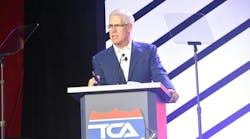The comments are rolling in on the Federal Motor Carrier Safety Administration’s latest proposed Hours of Service (HOS) rules, which were published in the Dec. 29, 2010, Federal Register.
And after Fleet Owner reviewed a sampling of the nearly 1,100 comments so far, there is one common theme emerging: Trucking stakeholders are not happy with the proposed rulemaking.
The proposal, which the public can comment on until Feb. 28, 2011, would retain the 34-hour “restart” provision that now allows drivers to “restart the clock” on their weekly 60 or 70 hours by taking at least 34 consecutive hours off-duty. Under the proposed rules, the restart provision would mandate two consecutive off-duty periods from midnight to 6 a.m., usable just once within a seven-day period.
The proposed rule would also require truckers “to complete all driving within a 14-hour workday, and to complete all on-duty work-related activities within 13 hours to allow for at least a one- hour break.”
It does not make a recommendation as to whether drive time can be 10 or 11 hours in day.
Read previous coverage from Fleetowner on HOS
Here’s but a sampling of comments sent to FMCSA thus far, as they appear on Regulations.gov.
“Changing the current HOS regulations is a very bad idea for many reasons. The proposed reduction in driving time and working hours will result in a need for more drivers, thus bringing more inexperienced drivers into the industry. As a result highway safety is a major concern based on their inexperience.”
--Richard C. Miller Jr.
“The proposed hours of service regulations for 2011 are going to put a ton of pressure on a struggling economy. Freight rates will have to rise 8% to 12% immediately if these new rules are put into place. What is the reason for the new regulations? If public safety is the issue, where is the evidence? It is easy to see that the reduction in driving time from 11 hours to 10 will produce more trucks and less qualified drivers on the road. The public will pay dearly if the proposed hours of service rules are put into place.”
--Josh Schmidt, Schmidt Liquid Services
Continue on to read more comments
“On behalf of Carlisle Carrier Corp. - we are submitting the following comments related to the Hours of Service rules for CMV operators currently proposed by FMCSA. …We are a safety conscious fleet with a progressive approach including electronic logging for all of our trucks. The only elements of the new rule we feel should be re-considered involve the changes to the 34 hour re-start provision. In a well-intentioned attempt to force a “circadian rhythm” on the trucking industry, the new rule creates unnecessary complexity and fails to achieve the goal. Contrary to the assumptions – Trucking companies do not establish driver’s schedules. Our customers and their customers have well established processes and appointment scheduling rules, and they dictate that much of our driving occur at night and occur when they demand the trucks arrive. Our regional driver fleet uses the 34 hour restart rule nearly every week. In many cases they get 40+ hours or more at home during their break. But 90 percent of traffic moves Monday-Friday and so most of our drivers arrive home some time Friday afternoon through Saturday very early AM and start out again Sunday night or early Monday AM. Some drivers choose to break in transit on the way home Friday after a long week before they complete transit home. Monday delivery schedules are established well ahead of these events. There is no way to be sure whether a driver will arrive home by or before midnight on Friday. A 10 minute difference between 1155PM Friday night and 0005 Sat AM will now involve a huge difference in what the driver can do next… We respectfully ask that you reconsider this element of the proposal. FMCSA would be better served to require all fleets to use EOBRs for logging- and properly enforce the rules where fleets are abusing them creating far greater risk to public safety than the 34 hour restart as it is currently written. Thank you for your consideration.”
--Christopher Peters, vp of operations- Carlisle Carrier Corp.
“I believe the 34 hour restart is more than enough time. By the time you are dispatched you are normally closer to 40 hours. If they change the rules we’re put in a place where you would end up with over 48 hours off. This would prompt the companies to put another driver in the truck to put it to good use and both drivers would make a lot less money.”
--Josh Taylor
“A reduction in driving time and working hours will trigger a need for more inexperienced drivers. As a result, highway safety will surely suffer. The proposed changes will strike a blow to a struggling economy. Since the industry will have less capacity to haul freight, rates will rise substantially. Critical components of the nation’s distribution network will be disrupted. Existing routes and distribution centers have been designed around the current Hours of Service rules. Fewer driving and working hours amounts to a pay cut for truck drivers, at a time when drivers and their families are already struggling to make ends meet.
--Duncan Kilgore
“Being a former over the road driver I personally believe due to new modern equipment we have the driving hours should be 12. As a former owner of a small trucking company I believe by reducing the driving hours it will require company’s to slip-seat drivers which in my opinion would increase the potential for accidents and breakdowns.”
--Max Coleman
“I keep running into problems were I can manage my time better than the government and have included this recent example. After finishing a load to Presque Isle, Maine I had to do a 34 hour restart because I haul produce. The longer the product sits in the truck the less it sits on the store shelves and the more gets thrown away because it goes bad before it is sold.”
--Francis Patrick Hopkins
“I think the 34 hour reset is good the way it is now. When we could split the sleeper berth it allowed me to stop and take a break in case of an accident, bad weather, traffic or I just got sleepy. We need some flexability in our day because of the many situations during our driving day. I deliver mostly in the early morning hours, so, If I start early and sit for 3 or 4 hrs or more at a reciever, my productivity will suffer. Why not make the shippers & recievers more responsible for wasting drivers time? Mandating when someone should sleep or take a break is absurd!!I would hope they would just leave the rules like they are now. I'm on e-logs and I think everybody should be!”
--Rex A. McCoy
“We are a California based company. We are currently under siege from the state-government regarding use of our equipment. We are being mandated to update, sell, scrap, and underutilize our equipment here. We do not need any more regulation change to hamper the recovery of the economy.
The federal government has already changed the HOS rules not but a few years ago. The changes were not comfortable to deal with but we did. Those rules had not been changed for 60 yrs! Now special interests are pulling our legislators to change the rules once again. This is preposterous! There is no reasonable reason to change them again. It has been noted the current rules have saved lives.”
--Chris Torres, F & L Farms Trucking Inc
“Shenandoah supports no changes to the HOS rules.”
--Shenandoah Trucking
“I am writing to offer our opinion of the proposed changes to the DOT’s Hours of Service (HOS)
regulations. The current regulations have helped decrease large truck and bus fatalities by 29.27% from 2007 through 2010. Though the exact reduction attributable to current HOS rules is not immediately available through MCMIS and NHTSA data, the trending within the transportation industry has shown a decrease never before realized by any industry.
It is very difficult to argue the current system is not working. Even the signatories of the litigation
settlement agreement with the DOT cannot point to any data increase revealing a flaw in the thorough
and exhaustive HOS rules set in place by your predecessors.
Drivers and employers have worked with the DOT to implement a sweeping revision of the HOS rules
and the benefits are evident; large reductions in fatalities, injuries and Out‐of‐Service orders issued by
federal and state authorities tell the tale. Please do not set out to fix a program that clearly isn’t broken.”
--Grant Campbell, Lee Jennings Target Express Inc.
“A flawed but relatively simple set of rules made much more complicated! Reducing the driving window by 1 hour is ridiculous! Any driving window encourages a driver to press on when fealling fatigued when they could greatly benefit from a short nap. The “Break” in the driving time does little to address this and cuts into an allready limited amount of time to complete the days driving.”
--Steven James Kessler
“Why should the ‘safe driving window’ be any different for a property carrying motor carrier driver than, say, a bus driver? Are bus drivers somehow not affected by driver fatigue? As for this ‘no on duty status after the 14 hrs mark’ idea, currently, a driver cannot drive after the 14 hrs have elapsed until they complete a 10 hour break. If the driver is on duty for 48 hours consecutively, it does not affect highway safety in the least since the driver cannot operate again until he completes a 10 hour break. Regulating consecutive on-duty hours (when the driver is not driving after the 14 hour window has elapsed) is not going to improve highway safety, which is the goal of the FMCSA.”
--Kyle Francis Quigley
“I have no problem with the current hours of service, by adding in a 30 minute mandatory break will just put me under the wheel for a longer period. You can’t put all the responsibility for safety on the backs of the American Truck driver only…”
--William K. Cornwell
“1. The 11 hour driving time should be left as is. 2. 34 hour restart is good as sugested. 3. Manditory break is not a good way to be regulated I thought we arnt regulated we should have more flexability and stop the clock and rest when we are tired not when somebody tells us when we are tired.Let us take a break when we can fit it into our day.
--Merle Allen Pilger, Sr
“My comments on the hours of service is that the 11 hour driving needs to stay the same. Im no less tired at 11 then i am at 10 also we do not need a 30 min break being mandatory there are certain types of trailors like doubles that are hard to find parking for your going to be forcing drivers to illeagaly park especially at night for there 30 min break. i like the 14 hour rule and i think the 34 hour restart needs to be extended to a 48 hour restart.”
--John Wade Kegley
“While I appreciate the idea behind the mandatory break before 7 hours of driving, here is the issue I have with that. There are times when we as drivers try to avoid rush hours by taking a break at the beginning of the traffic build-up and waiting it out. Other time we need to keep driving to beat it. The mandatory break could put us in a situation where we have to break, and then get back out on the road during rush hour. That would add to congestion and put us into a situation we could have otherwise avoided. If the break must be mandatory, at least give us the flexibility when to take it.”
--Clark Reed




